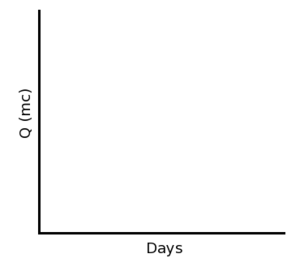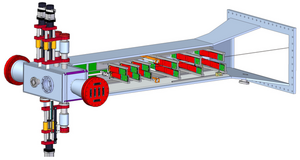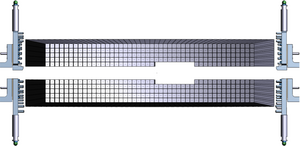Difference between revisions of "The HPS Run Wiki"
| Line 142: | Line 142: | ||
| − | == Run Plan: March | + | == Run Plan: March 30-April 5, 2015 (day/swing/owl) == |
| − | CHL1, which supplies the South Linac, has serious mechanical difficulties with a compressor. CHL2 has | + | All shifts are cancelled. Machine is down for the week. CHL1, which supplies the South Linac, has serious mechanical difficulties with a compressor and won't be available for this run. CHL2 has contaminants in the heat exchanger, and should be recoverable. We'll know more later in the week, including how JLAB management will deal with the problems. |
| − | '''<font size=3>All HPS | + | '''<font size=3>All HPS shifts March 30-April 5 are cancelled </font>''' |
| − | While the prognosis is not good, it | + | While the prognosis is not good, it should be possible to run a low energy program that uses just one CHL. This could possibly provide HPS with beams of 1.1 and 2.2 GeV. High energy (10-11 GeV) running would not be possible in this scenario. |
| − | When we're back: 1) MCC re-tunes upstream beam;(2) When beams are acceptable, MCC restores beams to alcove;(3) When decent beams have been reestablished, calibrate downstream bpms (4) post calibration, require good spot on Chromax, low counts on halo counters, and then set-up chicane. 5) scan target vertically and horizontally, measure halo rates vs target; (5) Take data. Subsystem commissioning studies: more trigger commissioning studies, beam trip studies once orbit locks are on. | + | When we're back, we'll resume our program: 1) MCC re-tunes upstream beam;(2) When beams are acceptable, MCC restores beams to alcove;(3) When decent beams have been reestablished, calibrate downstream bpms (4) post calibration, require good spot on Chromax, low counts on halo counters, and then set-up chicane. 5) scan target vertically and horizontally, measure halo rates vs target; (5) Take data. Subsystem commissioning studies: more trigger commissioning studies, beam trip studies once orbit locks are on. |
'''<font size=3> When we're back, proceed with program </font>''' | '''<font size=3> When we're back, proceed with program </font>''' | ||
Revision as of 09:51, 30 March 2015
Important Phone NumbersShift ScheduleShift-Taker's Checklist (old)Hot CheckoutBeam Time AccountingHPS Run Spreadsheet |
Procedures
|
Manuals |
JLab Logbooks
|
RC: John Jaros
PDL: Stepan StepanyanEvery Shift:
SVT InstructionsBefore sending beam to Faraday cup, verify (and page SVT expert if otherwise):
The first time sending beam to the Faraday cup after the hall is closed, page the SVT expert.
Acceptable Beam Conditions:Before accepting beam, make sure all the conditions are met - beam profile and halo rates are what you expect (or very close to it). If unsure call to RC, PDL, or beamline expert!
Always read previous log entries, compare settings of BPMs and correctors with previous settings using scaler_hps GUI. Every Run:
|
Run Plan: March 30-April 5, 2015 (day/swing/owl)All shifts are cancelled. Machine is down for the week. CHL1, which supplies the South Linac, has serious mechanical difficulties with a compressor and won't be available for this run. CHL2 has contaminants in the heat exchanger, and should be recoverable. We'll know more later in the week, including how JLAB management will deal with the problems. All HPS shifts March 30-April 5 are cancelled While the prognosis is not good, it should be possible to run a low energy program that uses just one CHL. This could possibly provide HPS with beams of 1.1 and 2.2 GeV. High energy (10-11 GeV) running would not be possible in this scenario. When we're back, we'll resume our program: 1) MCC re-tunes upstream beam;(2) When beams are acceptable, MCC restores beams to alcove;(3) When decent beams have been reestablished, calibrate downstream bpms (4) post calibration, require good spot on Chromax, low counts on halo counters, and then set-up chicane. 5) scan target vertically and horizontally, measure halo rates vs target; (5) Take data. Subsystem commissioning studies: more trigger commissioning studies, beam trip studies once orbit locks are on. When we're back, proceed with program MCC works on beam optics and matching, and tunes beam to tagger
Standards are on this page: ACCEPTABLE BEAM CONDITIONS.
Restore Beam to the Hall-B Dump
Energize Chicane
Be very careful when changing magnet currents when beams are on. Must enter new current ACCURATELY. Small steps (few amps) only.
Are we centered? Beamline Expert should enter new target positions if not.
Subsystem Commissioning Studies. Begin Data Taking. DO NOT RUN MORE THAN 30 MINUTES ABOVE 50 nA WITHOUT THE BEAM BLOCKER
| ||||||||||||||||||||||||||||||||||||||||||||||
|
|
| ||||||||||||||||||||||
|
|
|
| ||||||||||||||||||||||||||||||||||||||||||||||
|
Webcams:
|
Slow Controls: |
Accelerator:
|
Online & Offline: |


